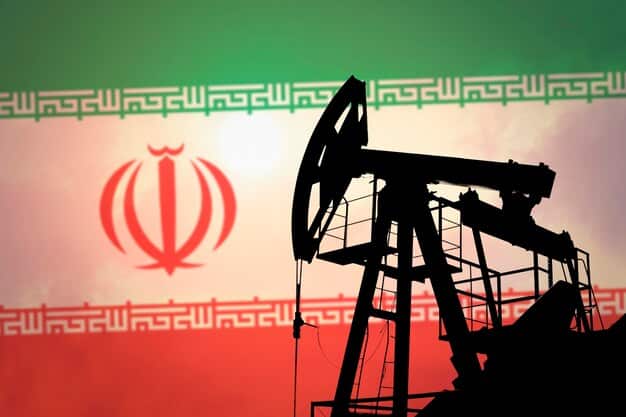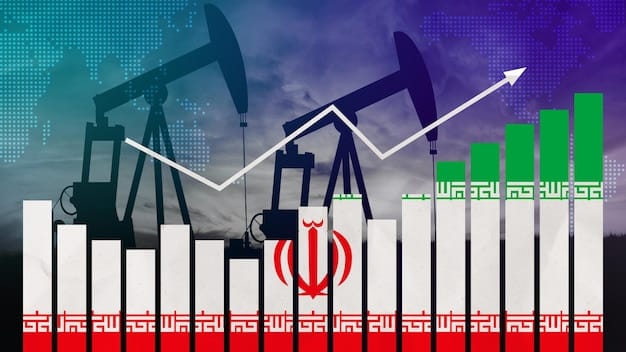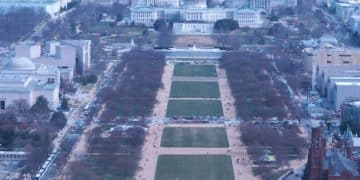US Sanctions Against Iran: Effectiveness & Escalation Potential

US sanctions against Iran aim to curb its nuclear ambitions and regional influence, but their effectiveness is debated, with concerns about humanitarian impact and the potential for escalation in the next three months amid ongoing geopolitical tensions.
The imposition of US Sanctions Against Iran: Evaluating the Effectiveness and Potential for Escalation in the Next 3 Months has been a cornerstone of American foreign policy towards Iran for decades. With the ever-changing political climate, understanding the efficacy and possible future escalations has never been more critical.
The History of US Sanctions on Iran
The story of US sanctions against Iran is complex, unfolding across decades and influenced by shifting geopolitical goals. Understanding this history is vital for assessing the current situation and predicting future trends.
Early Sanctions and the Iranian Revolution
The initial sanctions were imposed following the 1979 Iranian Revolution, driven by concerns over human rights and Iran’s support for terrorism.
Broadening of Sanctions Over Time
Over time, the scope of sanctions expanded to include Iran’s nuclear program, its ballistic missile development, and its role in regional conflicts.
- Economic pressures have significantly impacted Iran’s oil exports.
- Financial sanctions have limited Iran’s access to the international banking system.
- Trade restrictions have hampered Iran’s ability to import essential goods.
The historical context provides a crucial understanding of the complex relationship between the US and Iran and how sanctions have evolved into a primary tool of US foreign policy.
Economic Impact of US Sanctions
US Sanctions Against Iran: Evaluating the Effectiveness and Potential for Escalation in the Next 3 Months must take into account the extensive economic consequences for Iran. These sanctions have affected nearly every sector of the Iranian economy.

The oil industry, a cornerstone of Iran’s economy, has been significantly affected by sanctions targeting Iran’s oil exports.
Sanctions impacting the financial sector have made it exceedingly difficult for Iran to conduct international business and trade.
- Reduced government revenue due to decreased oil exports.
- Increased unemployment rates as businesses struggle and close down.
- Higher inflation rates making essential goods and services more expensive for average Iranians.
The economic impact of US sanctions extends beyond mere statistics, influencing everyday life for Iranians and affecting the overall stability of the region.
The Nuclear Program and Sanctions Relief
Iran’s nuclear program is at the heart of many US sanctions. The international community’s efforts to limit this program have involved negotiations and sanctions relief agreements.
The 2015 Iran Nuclear Deal, known as the Joint Comprehensive Plan of Action (JCPOA), offered Iran sanctions relief in exchange for restrictions on its nuclear activities.
The US Withdrawal from the JCPOA
In 2018, the US withdrew from the JCPOA and reimposed sanctions, claiming that the deal was insufficient to prevent Iran from developing nuclear weapons.
The reimposition of sanctions led Iran to gradually reduce its compliance with the JCPOA, raising concerns about the potential for nuclear proliferation.
- Diplomatic efforts to revive the JCPOA have faced various obstacles.
- Iran has increased its uranium enrichment levels in response to sanctions.
- The international community remains divided on the best approach to address Iran’s nuclear program.
The interplay between sanctions, nuclear ambitions, and international agreements significantly shapes the dynamics of US-Iran relations.
Humanitarian Consequences
Beyond the economic and political impacts, US Sanctions Against Iran: Evaluating the Effectiveness and Potential for Escalation in the Next 3 Months have had significant humanitarian consequences for the Iranian people.

Restrictions on trade and financial transactions have made it harder for Iran to import essential medical supplies and humanitarian goods.
Increased poverty and unemployment have affected access to basic necessities like food, water, and healthcare.
- Shortages of life-saving medications for chronic diseases.
- Increased malnutrition rates, especially among vulnerable populations.
- Reduced access to clean water and sanitation, leading to public health crises.
Understanding the humanitarian aspects of sanctions is crucial for a comprehensive evaluation of their overall impact.
Potential for Escalation in the Next Three Months
The next three months are critical in assessing the potential for escalation in US-Iran relations. Several factors could contribute to increased tensions.
Continued economic pressure from sanctions could push Iran to adopt more aggressive measures.
Regional Conflicts and Proxy Wars
Escalation in regional conflicts, where Iran and the US support opposing sides, could further destabilize the region.
A miscalculation or incident in the Persian Gulf could trigger a military confrontation between the US and Iran.
- Increased naval presence and military exercises in the region.
- Heightened rhetoric and diplomatic tensions between the two countries.
- Cyberattacks and other forms of asymmetric warfare.
Monitoring these developments is crucial to understanding the trajectory of US-Iran relations and minimizing the risk of escalation.
Alternative Approaches to US Policy on Iran
Given the complexities and potential drawbacks of sanctions, alternative policy approaches toward Iran are worth considering.
Renewed diplomatic efforts to revive or renegotiate the JCPOA could provide a pathway to de-escalation and cooperation.
Targeted Sanctions and Human Rights
Implementing targeted sanctions that focus on specific individuals and entities involved in human rights abuses or illicit activities may be more effective.
Promoting people-to-people exchanges and cultural diplomacy could help bridge the gap between the two countries.
- Offering incentives for compliance with international norms and agreements.
- Engaging in multilateral diplomacy with other key stakeholders in the region.
- Supporting civil society organizations and human rights activists in Iran.
Exploring alternative approaches could lead to a more sustainable and effective US policy toward Iran.
| Key Point | Brief Description |
|---|---|
| 📜 History | Sanctions began post-1979 revolution, broadened over time. |
| 📉 Economic Impact | Oil exports declined, financial restrictions increased unemployment. |
| ☢️ Nuclear Program | JCPOA offered relief, but US withdrawal reimposed sanctions impacting nuclear activities. |
| 🕊️ Alternatives | Diplomacy, targeted sanctions, and cultural exchanges as options. |
FAQ
▼
The primary goals include curbing Iran’s nuclear ambitions, limiting its support for terrorism, and addressing its human rights record.
▼
Sanctions have led to reduced oil exports, limited access to international banking, increased unemployment, and high inflation rates in Iran.
▼
The JCPOA was a nuclear deal offering Iran sanctions relief for restricting its nuclear activities. The US withdrew, citing concerns about its scope.
▼
They include shortages of essential medicines, increased malnutrition, and reduced access to clean water, affecting vulnerable populations the most.
▼
Alternatives include renewed diplomatic efforts, targeted sanctions on human rights abusers, and promoting cultural diplomacy to bridge gaps.
Conclusion
US Sanctions Against Iran: Evaluating the Effectiveness and Potential for Escalation in the Next 3 Months, while intended to modify Iran’s behavior, have resulted in wide-ranging economic, humanitarian, and geopolitical consequences. As tensions persist, exploring alternative policy approaches and diplomatic solutions becomes increasingly vital to ensuring regional stability and preventing further escalation.





